By 8.00pm BST yesterday, the rare transit of Mercury as it passed in front of the Sun, had come to a close. The event, that occurs due to the alignment of the Sun, Mercury and Earth, is a phenomenon that happens just a dozen or so times per century and if you didn’t get the chance to see it, then you will have to wait until 2019 before the opportunity arises again.
Countries in the northern hemisphere (if the weather was favourable) had the best chance of witnessing the smallest recognised planet in the Solar system, seen as a tiny black dot, inch its way over the surface of the Sun.
According to the Royal Astronomical Society (RAS) in the UK, most of Western Europe, the western parts of North and West Africa, eastern North America, and most of South America were able to view the entire transit and indeed special events were held at the RAS to aid the public in watching the event safely, as with any observing event that includes the Sun, amateur star-gazers were warned ahead of time to make use of a solar filter to watch the event unfold as only a very small part of the Sun was blocked out.
 Mercury's transit across the Sun. Image Credit NASA/Paris Observatory
Mercury's transit across the Sun. Image Credit NASA/Paris Observatory
“It’s a chance to feel you are really part of the solar system in motion.” said Dr Marek Kukula public astronomer at the Royal Observatory in Greenwich. "It is always exciting to see rare astronomical phenomena such as this transit of Mercury," added RAS President Martin Barstow. "They show that astronomy is a science that is accessible to everyone."
Due to its close proximity to the Sun, Mercury is literally a planet of two halves - during the day, half of its surface is six times hotter than the hottest place on our planet, and on a night, it is twice as cold as the coldest place on Earth. Equally fascinating is the length of one day on Mercury. Because the planet rotates so slowly – three times for every two orbits – a day on Mercury is twice as long as its year.














